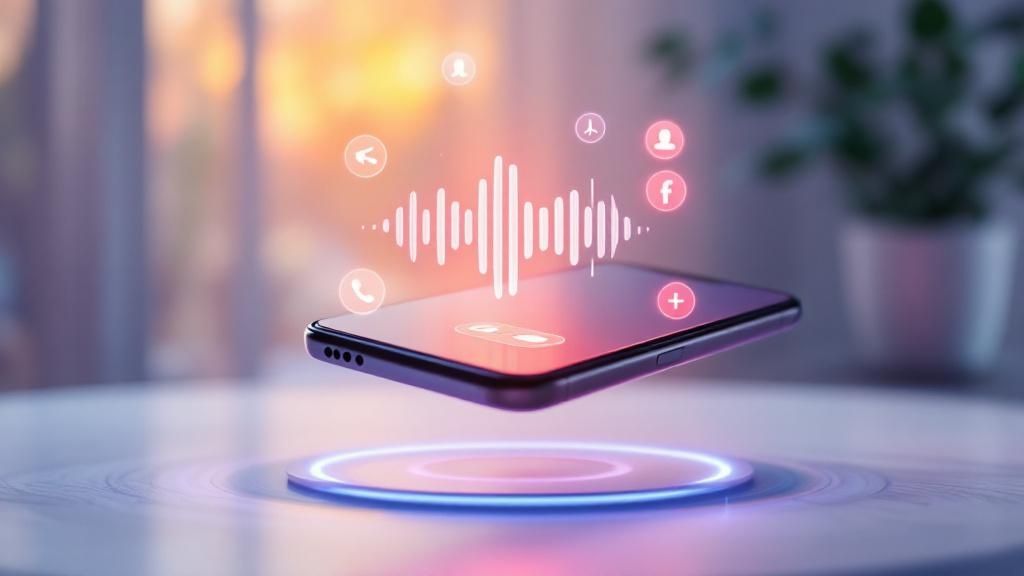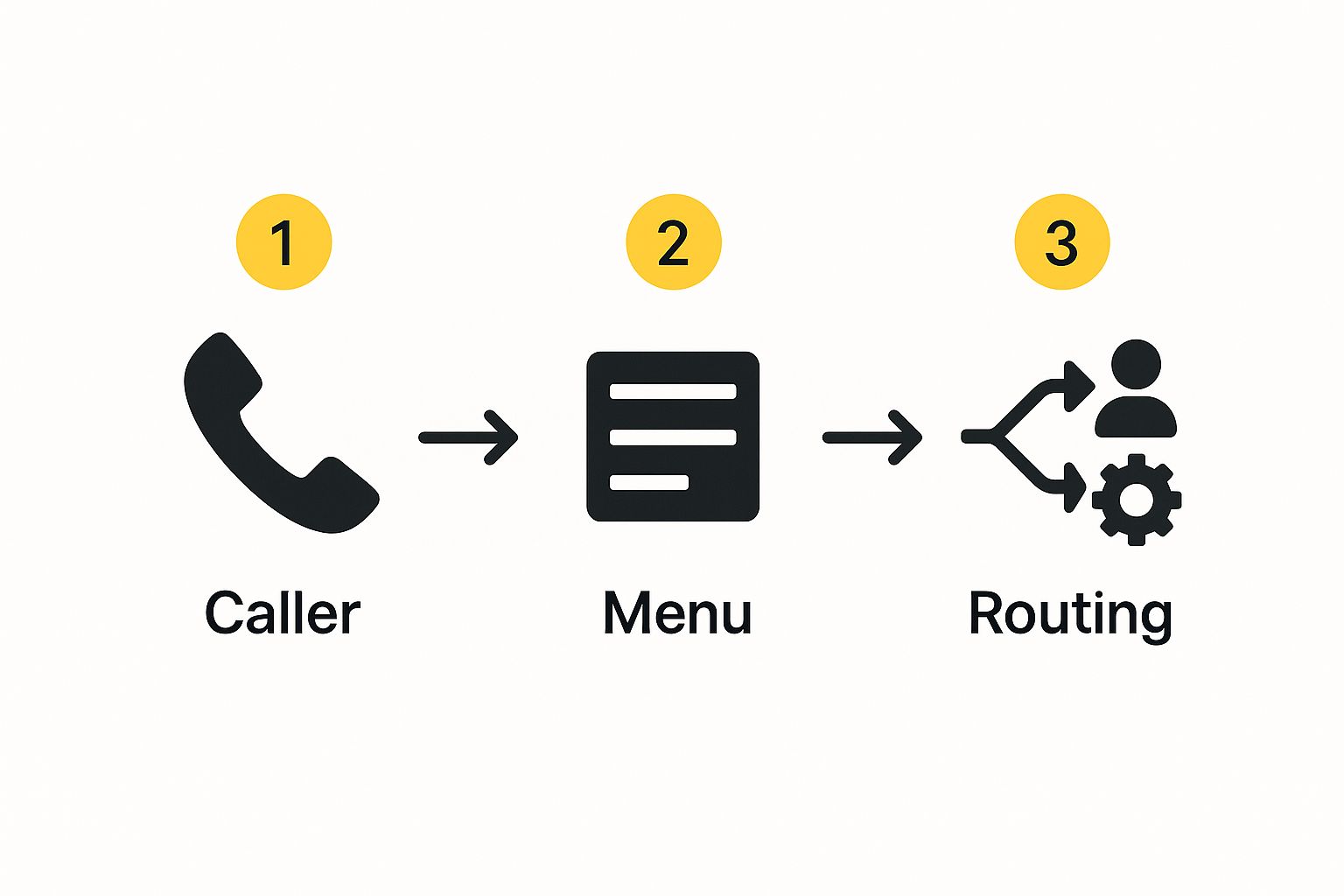If you’ve ever called a business and heard a friendly voice say, "Press 1 for sales, press 2 for support," you've already had a run-in with an Interactive Voice Response (IVR) system.
Think of it as your business’s digital receptionist. It’s always on, working 24/7 to greet your callers, understand what they need, and get them to the right place—all without you lifting a finger.
Your First Encounter with IVR

So, what exactly is interactive voice response? At its heart, it’s an automated phone system that sorts and manages incoming calls, making sure your customers get help quickly and efficiently.
It’s a massive leap from the old answering machine that just takes messages. An IVR doesn't just record; it actively engages with the caller from the moment they dial.
An IVR doesn't just take a message; it starts a conversation. It identifies, segments, and routes callers in real-time, creating a more organised and responsive communication channel for any business.
This is exactly why it’s become such a game-changer for modern businesses. It lets you deliver a top-notch customer experience without bogging down your team with endless phone calls.
How IVR Streamlines Communication
The whole system works using pre-recorded prompts that offer a menu of options. When a caller makes a choice, the IVR springs into action.
This could mean a few different things:
- Routing the call straight to a specific person or department, like accounts or technical support.
- Providing self-service info, like an account balance or the status of an order, so the caller doesn't have to wait for a human.
- Collecting key details from the caller before connecting them to a live agent, saving everyone time.
This automated process is a lifesaver for businesses of all shapes and sizes. Here in Australia, Interactive Voice Response systems have become a cornerstone for small and medium businesses, especially in bustling cities like Sydney and Melbourne.
IVR automates the whole call routing dance, allowing businesses to handle a high volume of calls without those frustratingly long wait times. If you want to dig deeper into how Aussie businesses are using this tech, you can get more insights on IVR adoption in Australia.
Ultimately, it’s this efficiency that paves the way for a much smoother, more professional customer journey.
How an IVR System Actually Works
Ever wondered what’s happening behind the scenes when you call a business and a friendly voice asks you to "press 1 for sales"? Think of an IVR system as a smart, digital switchboard operator who’s been given a very specific script—or what we call a ‘call flow’.
The moment you dial, the IVR springs into action. It answers instantly and kicks off its pre-programmed sequence, guiding you from that first "hello" all the way to where you need to be.
This whole process relies on a few key technologies working in perfect harmony. Today's IVR systems are built on some pretty clever communication infrastructure, with many running on robust hosted Voice over IP (VoIP) solutions. In simple terms, VoIP tech turns your voice into digital data and sends it over the internet, which is the backbone of the entire call.
The Caller's Journey, Step by Step
Once you're connected, the IVR needs to understand your choices. At its most basic, it listens for Dual-Tone Multi-Frequency (DTMF) signalling. That’s just the fancy, technical name for the unique sound each key on your phone makes when you press it.
At the same time, you’re hearing a series of pre-recorded audio prompts that lay out your options. It's this simple combination—audio instructions and keypad presses—that lets the system route your call correctly.
But modern systems have a few more tricks up their sleeve:
- Speech Recognition: This lets you say what you want instead of fumbling with the keypad. Much easier, right?
- Natural Language Processing (NLP): This is the clever AI part. It doesn't just hear your words; it understands what you mean, making the whole thing feel more like a real conversation.
This simple visual breaks down the call flow, showing how a caller moves from the initial ring, through the menu, and on to the right person or department.

The goal is to sort and handle every call efficiently, without a human needing to step in. Whether you end up talking to a live agent, getting information from a database, or leaving a message with a smart voicemail like OnSilent, each step is designed to get you there faster.
The Real-World Benefits of Using an IVR

Once you get what interactive voice response is, it’s easy to see why so many businesses are jumping on board. The perks go way beyond just having a system to answer the phone; they directly boost your efficiency, cut costs, and shape how customers see your brand.
By automating the simple, repetitive questions and getting callers to the right place, an IVR frees up your team. This lets your staff focus their skills on the tricky problems where a human touch really makes a difference, lifting the whole team's productivity.
This automation is also a massive win for your bottom line. Instead of hiring more people to handle a flood of calls, an IVR works like a tireless digital receptionist, making sure every call gets handled right away. For Australian businesses, a smart IVR setup can slash customer service costs by up to 30%. You can discover more about IVR market trends to get the full picture of the financial upside.
A Better Experience for Your Customers
An IVR system seriously improves the customer journey by being available 24/7, instantly. Let's be honest, modern customers expect to be able to help themselves. An IVR gives them exactly that, letting them check an order status or find your business hours without having to wait in a queue for an agent.
This immediate access cuts out a lot of frustration. In fact, 75% of customers get angry if they can't get through to an agent straight away, which really highlights the need for a slick, efficient routing system.
A well-designed IVR doesn’t create roadblocks; it builds pathways. It guides customers to the right solution quickly, whether that’s a self-service option or the best person to solve their problem.
Finally, an IVR just makes you look more professional. It can make even a small business seem bigger, more organised, and totally capable of handling whatever customers throw at it.
When you pair it with other great tools, like effective call management software, you create a powerful, seamless communication system. This organised approach builds trust and shows customers you value their time, turning a simple phone call into a genuinely positive experience with your brand.
IVR Use Cases in Action
To really get your head around what interactive voice response is, it helps to see how it works in the real world. IVR tech isn't just for massive call centres; all sorts of businesses use it to solve specific, everyday headaches and simply communicate better with their customers.
Think of it as a versatile tool that adapts to different needs, turning a standard phone call into a slick, automated process.
Streamlining Daily Operations
In banking and finance, IVR is pretty much the backbone of customer self-service. It lets customers securely check their account balance, look over recent transactions, or report a lost card—all without ever needing to chat with a person. This simple shift frees up bank staff to handle the more complex stuff, like financial advice and support.
It's a similar story in healthcare. IVR systems can manage appointment scheduling and reminders, handle prescription refill requests, and give out clinic hours. This level of automation cuts down the administrative load and minimises the risk of human error, letting medical staff focus on what they do best: patient care.
For retail and e-commerce businesses, IVR is a lifesaver for customer support. It gives callers instant updates on their order status, processes return requests, and provides product info. This is a massive help for managing huge call volumes, especially during peak shopping seasons.
By automating routine enquiries, an IVR system allows service-based professionals to prioritise high-value interactions. It acts as a digital gatekeeper, ensuring urgent client needs are addressed immediately while routine calls are handled efficiently.
Qualifying Leads and Prioritising Clients
Service-based businesses, like consultants or tradies, get a lot out of it too. An IVR can qualify new leads by asking a few quick questions right off the bat, then send them to the right person on the team. This ensures that urgent client matters are prioritised over general enquiries. By implementing intelligent call routing, businesses can set up a tiered system that directs calls based on urgency and client value.
A lot of these call centre applications are built on some pretty advanced communication tech. To get a better feel for the infrastructure that makes it all happen, it's worth learning a bit more about VoIP for call centers and how it powers modern IVR solutions. Each example just goes to show how IVR solves a real business challenge, making its value crystal clear.
From Keypads to AI: The Big Leap in IVR Tech

Interactive Voice Response (IVR) has come a seriously long way. Remember those clunky, repetitive "press one for sales, press two for accounts" menus? Those early systems were rigid, forcing you down a pre-set path with your keypad.
While they got the job done (sometimes), it was a recipe for frustration when your problem didn't neatly fit into one of the neat little boxes they gave you.
But that old-school tech has had a major upgrade. The biggest game-changer? The arrival of Conversational IVR, a much smarter system that uses artificial intelligence to make the whole experience feel more natural and human.
Conversational IVR doesn't just listen for button presses; it actually understands what you're saying. It uses something called Natural Language Processing (NLP) to figure out what you mean, turning a one-way shouting match with your phone into a genuinely productive chat.
Turning Missed Calls into Real Opportunities
This ability to understand spoken language is huge. Instead of a robotic menu, an AI-powered system can grasp why someone is calling and either solve their problem on the spot or get them to the right person, fast. For any business, that means quicker resolutions and much happier customers.
Now, that same smart logic is being applied beyond live calls. Modern tools are taking the same principles and using them on missed calls and voicemails, transforming what used to be a dead end into a genuine opportunity.
An automated phone answering system can analyse a voicemail, pinpoint what the caller needs, and tag it for immediate follow-up. It means you never miss a beat, even when you can't get to the phone, creating a seamless link between the calls you take and the ones you miss.
Your IVR Questions, Answered
Even after getting the gist of what interactive voice response is all about, you probably still have a few questions floating around. It's a powerful bit of tech, so it’s only natural to wonder about the nitty-gritty details and how different systems stack up.
Let's tackle some of the most common queries we hear from business owners.
What's the Real Difference Between an IVR and an Auto-Attendant?
While both systems pick up the phone for you, it helps to think of an auto-attendant as a simple switchboard operator. Its main gig is to give callers a basic menu to connect them to the right person or department. It’s a one-trick pony, but a handy one at that.
An IVR, on the other hand, is a whole different beast. It's much more advanced, capable of plugging into your business databases to give out personalised info, like checking an account balance or the status of an order. It can even wrap up entire transactions without a human lifting a finger.
An auto-attendant just directs traffic. An IVR is a full-blown self-service portal that can solve a caller's problem from start to finish.
Is IVR Technology Too Expensive for a Small Business?
It certainly used to be, but those days are long gone. In the past, getting an IVR meant forking out for pricey, on-premise hardware that was well out of reach for most small businesses.
Thankfully, cloud computing and VoIP have changed the game. Today, IVR is offered as an affordable, hosted service. These subscription-based models have made the technology accessible for small and medium-sized businesses across Australia, getting rid of the need for a massive upfront investment.
Can an IVR System Actually Talk to My Other Business Software?
Absolutely—and that’s where the real magic happens. A standout feature of modern interactive voice response systems is their ability to link up with the other essential tools you use to run your business.
This connection allows for a much smarter, more personal touch with your customers. For instance, an IVR can:
- Dip into your CRM to greet a caller by name ("G'day John, are you ringing about your recent order?").
- Log new support tickets in your helpdesk system based on what the caller needs.
- Update customer records automatically once the call is done and dusted.
This kind of connectivity turns your phone system from a simple way to talk into an intelligent, active part of your day-to-day operations.
Ready to stop missing opportunities and start managing your calls more intelligently? OnSilent turns every missed call into an actionable lead, saving you time and making sure you never lose a client. See how OnSilent can transform your business communications today.

